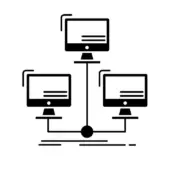Complex problems require big solutions, and big solutions require bold ideas. A concern that we often hear from our clients is that their internal teams approach design incrementally. It can be tough to change that type of thinking and style of working once the tendency sets in. And that’s what our ideation process is all about.
By using Design Thinking techniques, your team can break out of the institutional thought patterns that keep big, bold ideas at bay. Micro solutions to specific aspects of big picture problems can only take you so far. Use our process to dig deeper, figure things out, and determine what’s best for your users.
Accurate Solutions and Better Results: The Benefits of Proper Ideation Techniques and Guidelines
When problems develop with digital projects, quickly recognizing that there is a problem and diagnosing the root of that problem is difficult enough. Identifying the best solutions for those problems is even more difficult. Putting empathy first can improve your customer experience from the start, and identifying the right problem is critical when trouble does arise. But what comes next?
Even when organizations recognize that they have a problem, actually moving forward and solving that problem can seem daunting. But it all comes down to how you tackle the challenge ahead. How do you come up with ideas, and then translate them into needs that stakeholders can understand?
This is actually the fun part. Difficult, yes — but fun.
Now is the time to ideate. It’s time to gather the right, diverse team members, dig into the issues at hand, and get to work. It’s easier said than done, of course, but the key is to use a structured process like this in order to arrive at the solutions that will most benefit your users — not just following the other guy’s lead in the industry.
Getting the Most from Your Ideation Session
A successful ideation session is crucial to solving the problems that your digital product or project is facing. Don’t just grab anyone that’s available and tell them to brainstorm some solutions. Consider what you’ve learned through empathizing with your users and identifying the problems that they’ve encountered, and let those insights be your guardrails throughout ideation.
Gather Your Team
It’s important that you involve a team of 8-10 key stakeholders during the ideation process. You want to keep this team diverse, yet nimble. Be sure to include representatives from product, marketing, design, development, security, compliance, customer service, and a decision maker at the executive level when forming this team.
Gather Your Materials
Successful ideation doesn’t require complex resources. You’ll want some sort of digital collaboration tool, such as Miro, Mural, or Figma, in tandem with video conferencing software like Zoom or Teams, to facilitate the collaborative process. Beyond that, stock up your workspace with paper, post-it notes, and a whiteboard. Make sure you have plenty of pens, pencils, and markers on-hand. Even if you’re doing this remotely, having these physical materials on-hand for individual use can be helpful. Most importantly, though, is to make sure that everyone leaves their judgement at the door. The ideation room is for open-minds only.
Get Inspired
The great thing about finding inspiration is that it can happen at any point. We’ve included it here to kick off the work, but there’s no reason why you shouldn’t be looking out into the world for relevant examples of how others have approached similar issues throughout this process. Lead with inspiration, circle back to inspiration, and make sure you give your team time dedicated to sharing inspiration with others. Just be mindful that finding inspiration doesn’t turn into copying solutions and hoping they translate to your specific problem perfectly.
Get Started
Develop your problem statement or point of view question. What issue are you trying to solve? Who is the user, what are their needs, and what is the end goal? Have a clear, concise goal for what you want out of this session before diving in too deep. Is the goal of your ideation session simply to flesh out your problem statement fully? Are you looking for a couple of solid solutions to bring to a stakeholder meeting? Do you need a prototype example clearly defining your idea? Knowing what you want out of ideation and aligning everyone on that goal goes a long way toward ensuring a focused and productive session.
How to Do It: Specific Activities and Methodologies
In broad strokes, the goal of your ideation session is to generate as many ideas as possible. You also want to think big and bold. This can be a challenge for many organizations, even those with large, skilled, and innovative design teams. One tip to get you started: ideate individually, not as a group — at least not right away. This cuts the risk of the loudest voice in the room derailing the ideation session. We’ve seen great success at seeding ideas with individual ideation.
Brainstorming and Affinity Mapping
No judgement. We cannot stress this enough. When you’re brainstorming as part of this Design Thinking process, quantity breeds quality. You will toss out some clunkers as you sort through your ideas, but at this point, give everyone 15-30 minutes to generate as many of them as possible.
Once you’ve got those ideas out, you can start to group them together in the affinity mapping stage. Look for threads that link these ideas together naturally. Don’t force them. Larger solutions will start to present themselves, and you can review further from there.
Crazy 8’s
If your goal is to generate ideas rapidly, we recommend the Crazy 8’s sprint method. This simple technique requires nothing more than a sheet of paper and a pen. Take eight minutes to sketch out eight ideas.
Remix Ideas
Once you’ve got your first round of brainstorming done, remix your top ideas. Consider new and different ways to tackle ideas, like a “cronut” being baked in the manner of a croissant, but formed like a donut. Use these ideas as a jumping off point for further collaboration.
Mashup/Concept Monster
Similar to Remixing, the Mashup/Concept Monster methodology allows you to gain a new perspective on well-established platforms. Take two concepts, figure out what one is doing well, and apply it to the other. Turo, for example, is Airbnb for cars. Locals can rent out their cars to other people in the area. It’s not overly complicated, but it’s a unique play on an established idea.
Sketching
It doesn’t matter if you’re jotting down margin notes, creating boxes, or making stick figures. Sometimes the only way to get your idea across is to sketch it out. It’s simple and it’s effective, so don’t over complicate matters if this is the best way to express your thoughts.
You’ve Got Your Ideas. Now Round Them Out.
Rounding out your ideas requires that you collaborate to figure out which ones really have traction. This is where the concepts of converging and focusing come into play. Throughout the Design Thinking process so far, you’ve done a lot of diverging and flaring. You’ve explored a lot of different avenues, and generated (hopefully) tons of ideas. Ideation up to this point has been about opening up possibilities — and now it’s time to narrow it down. How do you do that?
Dot Voting
You’ve got your ideas mapped out and you’ve grouped them together naturally. Now give each participant a set of 5-8 dots and let them place their dots on those ideas that they think work best as a solution to your problem(s). This is a quick and easy way to visualize group consensus.
Impact vs. Effort Chart
Once you’ve voted on ideas, place them within an impact vs. effort chart. This helps to visualize how difficult they’ll be to achieve versus the impact it will have on the user’s experience. Of course, you’ll need to keep in mind the business impact, as well. You can use this process to develop a roadmap, asking what quick wins you can accomplish now, what you need to plan for in the future, what should not be done because it’s just not worth it, etc.
Leveraging Stakeholder Buy-In
By including your team of stakeholders in the ideation process, giving each of them a voice in its outcome, you’ve made them a part of the solution. There aren’t going to be any surprises to cause concern among stakeholders when presenting your ideas coming out of ideation, because they were part of the equation from the beginning. This makes stakeholder buy-in a natural outcome of the workshop process itself.
Successful Ideation Breeds Successful Solutions — So Follow the Process
When solving the problems that you encounter with digital projects, it’s important to seek inspiration from the world and industries around you. But you can’t just take existing solutions and expect to apply them successfully to your specific problems.
Following proper ideation techniques and guidelines is the key to finding the right solutions that generate better results.
In previous articles, we’ve talked about empathizing with your customers and identifying their specific problems. Following this ideation process to find solutions to those problems is the next logical step in the Design Thinking process.
Don’t hesitate to get in touch with any qustions that you may have.


